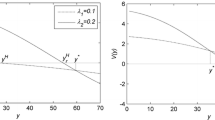Abstract
In this paper, inventory management of time-sensitive materials using RFID data is studied using simulation. Based on the production data obtained from a manufacturing company, three inventory management models that rely on RFID data for tracking and dispatching of time-sensitive materials on a shop floor is presented. The complexity of the models ranges from statically-set, fixed baseline inventory models to dynamic, forecast-integrated inventory control schemes. This study compares the inventory models on the basis of service level, cost, inventory and waste reduction, and decision-making complexity. A comparative analysis of the models is presented in a simulation environment, which also demonstrates the overall benefits and effectiveness of RFID technologies in providing low-cost manufacturing solutions, reduced inventory levels, and lower overall waste. The forecast-integrated inventory model is developed based on a trend-adjusted exponential smoothing algorithm, with two smoothing parameters, α and β, used as coefficients for the average production demand and its trend, respectively. The study shows that the desired level of system performance can be achieved by adjusting the values of the smoothing parameters.
Similar content being viewed by others
References
McFarlane D, Sanjay S, Chirn J-L, Wong CY, Ashton K (2003) Auto ID systems and intelligent manufacturing control. Eng Appl Artif Intell 16:365–376
Brewer A, Sloan N, Landers TL (1999) Intelligent tracking in manufacturing. J Intell Manuf 10:245–250
Lee YM, Cheng F, Leung Y-T (2004) Exploring the impact of RFID on supply chain dynamics. Proceedings of the 2004 Winter Simulation Conference 2:1145–1152
Katina M, McCathie L (2005) The pros and cons of RFID in supply chain management. International Conference on Mobile Business (IEEE Computer Society) 623–629
Engels DW, Foley J, Waldrop J, Sarma SE, Brock D (2001) The networked physical world: an automated identification architecture. Proceedings of the Second IEEE Workshop on Internet Applications, WIAPP 76–77
McFarlane D (2002) Auto ID-based control systems: an overview. IEEE International Conference on Systems, Man and Cybernetics 3:6–11
Penttila K, Sydanheimo L, Kivikoski M (2004) Performance development of a high-speed automatic object identification using passive RFID technology. IEEE Int Conf Robot Autom 5:4864–4868, New Orleans, LA
Gramling K, Bigornia A, Gilliam T (2003) IBM Business Consulting Services EPC Forum Survey. MIT Auto-ID Center White Paper
McFarlane D (2003) The impact of product identity on industrial control, Part 1: See More, Do More… MIT Auto-ID Center White Paper
Chappell G, Ginsbur L, Schmidt P, Smith J, Tobolski J (2003) Accenture Auto-ID on the line: the value of Auto-ID technology in manufacturing. MIT Auto-ID Center White Paper
Moran HJ, Sana A, McFarlane D (2004) Auto-ID use case: improving inventory visibility in retail company - impact on existing procedures and information systems. MIT Auto-ID Center White Paper
Moran HJ, McFarlane D, Milne TP (2003) Use case approach for determining the impact of Auto-ID implementations on business information systems. MIT Auto-ID Center White Paper
Garcia A, McFarlane D, Fletcher M, Thorne A (2003) Auto-ID in materials handling. MIT Auto-ID Center White Paper
Acknowledgements
This study was partially funded by the Air Force Research Lab (FA8650-04-C-704) through the Center for Aerospace Manufacturing Technologies (CAMT) at the University of Missouri-Rolla.
Author information
Authors and Affiliations
Corresponding author
Additional information
An erratum to this article can be found at http://dx.doi.org/10.1007/s00170-006-0616-1
Rights and permissions
About this article
Cite this article
Saygin, C. Adaptive inventory management using RFID data. Int J Adv Manuf Technol 32, 1045–1051 (2007). https://doi.org/10.1007/s00170-006-0405-x
Received:
Accepted:
Published:
Issue Date:
DOI: https://doi.org/10.1007/s00170-006-0405-x




